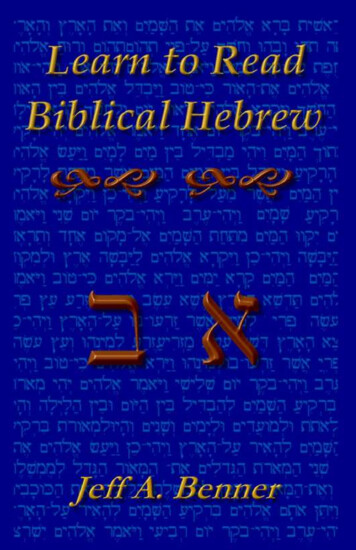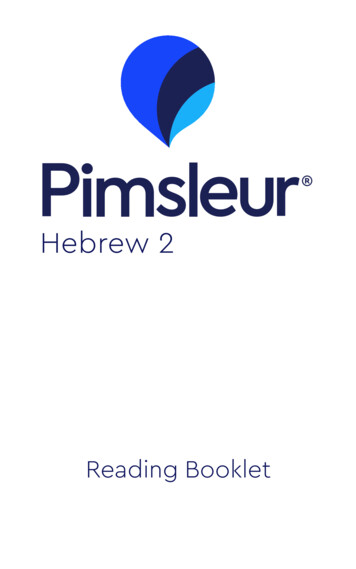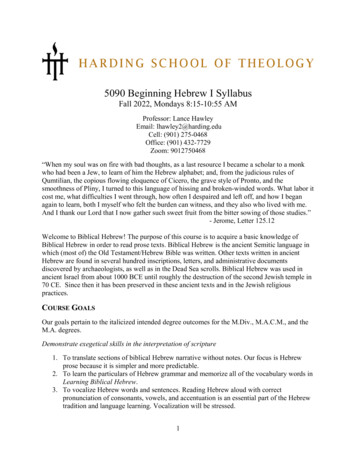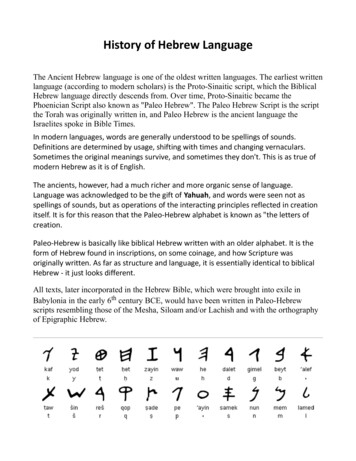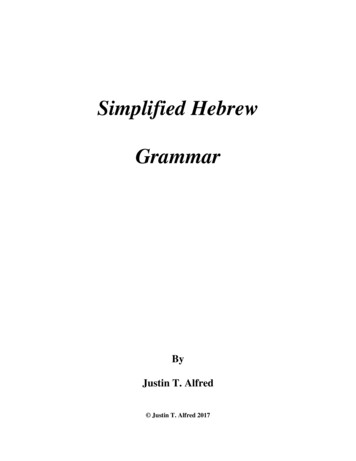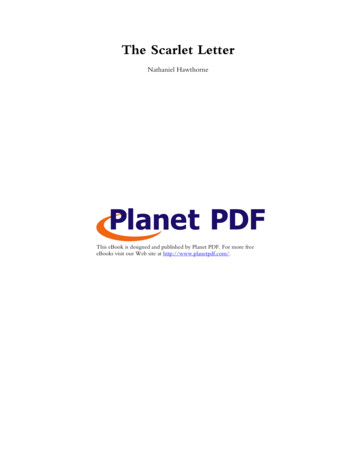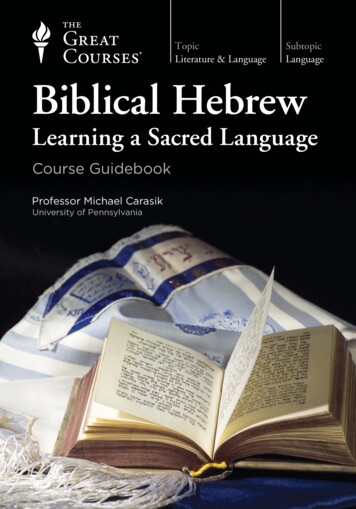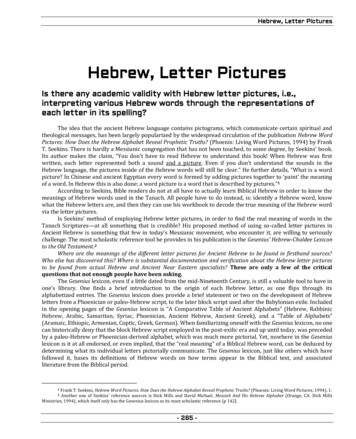
Transcription
Hebrew, Letter PicturesHebrew, Letter PicturesIs there any academic validity with Hebrew letter pictures, i.e.,interpreting various Hebrew words through the representations ofeach letter in its spelling?The idea that the ancient Hebrew language contains pictograms, which communicate certain spiritual andtheological messages, has been largely popularized by the widespread circulation of the publication Hebrew WordPictures: How Does the Hebrew Alphabet Reveal Prophetic Truths? (Phoenix: Living Word Pictures, 1994) by FrankT. Seekins. There is hardly a Messianic congregation that has not been touched, to some degree, by Seekins’ book.Its author makes the claim, “You don’t have to read Hebrew to understand this book! When Hebrew was firstwritten, each letter represented both a sound and a picture. Even if you don’t understand the sounds in theHebrew language, the pictures inside of the Hebrew words will still be clear.” He further details, “What is a wordpicture? In Chinese and ancient Egyptian every word is formed by adding pictures together to ‘paint’ the meaningof a word. In Hebrew this is also done; a word picture is a word that is described by pictures.”1According to Seekins, Bible readers do not at all have to actually learn Biblical Hebrew in order to know themeanings of Hebrew words used in the Tanach. All people have to do instead, is: identify a Hebrew word, knowwhat the Hebrew letters are, and then they can use his workbook to decode the true meaning of the Hebrew wordvia the letter pictures.Is Seekins’ method of employing Hebrew letter pictures, in order to find the real meaning of words in theTanach Scriptures—at all something that is credible? His proposed method of using so-called letter pictures inAncient Hebrew is something that few in today’s Messianic movement, who encounter it, are willing to seriouslychallenge. The most scholastic reference tool he provides in his publication is the Gesenius’ Hebrew-Chaldee Lexiconto the Old Testament.2Where are the meanings of the different letter pictures for Ancient Hebrew to be found in firsthand sources?Who else has discovered this? Where is substantial documentation and verification about the Hebrew letter picturesto be found from actual Hebrew and Ancient Near Eastern specialists? These are only a few of the criticalquestions that not enough people have been asking.The Gesenius lexicon, even if a little dated from the mid-Nineteenth Century, is still a valuable tool to have inone’s library. One finds a brief introduction to the origin of each Hebrew letter, as one flips through itsalphabetized entries. The Gesenius lexicon does provide a brief statement or two on the development of Hebrewletters from a Phoenician or paleo-Hebrew script, to the later block script used after the Babylonian exile. Includedin the opening pages of the Gesenius lexicon is “A Comparative Table of Ancient Alphabets” (Hebrew, RabbinicHebrew, Arabic, Samaritan, Syriac, Phoenician, Ancient Hebrew, Ancient Greek), and a “Table of Alphabets”(Aramaic, Ethiopic, Armenian, Coptic, Greek, German). When familiarizing oneself with the Gesenius lexicon, no onecan historically deny that the block Hebrew script employed in the post-exilic era and up until today, was precededby a paleo-Hebrew or Phoenician-derived alphabet, which was much more pictorial. Yet, nowhere in the Geseniuslexicon is it at all endorsed, or even implied, that the “real meaning” of a Biblical Hebrew word, can be deduced bydetermining what its individual letters pictorially communicate. The Gesenius lexicon, just like others which havefollowed it, bases its definitions of Hebrew words on how terms appear in the Biblical text, and associatedliterature from the Biblical period.Frank T. Seekins, Hebrew Word Pictures: How Does the Hebrew Alphabet Reveal Prophetic Truths? (Phoenix: Living Word Pictures, 1994), 1.Another one of Seekins’ reference sources is Dick Mills and David Michael, Messiah And His Hebrew Alphabet (Orange, CA: Dick MillsMinistries, 1994), which itself only has the Gesenius lexicon as its most scholastic reference (p 142).12- 265 -
Hebrew, Letter PicturesOn first glance, the claim that deriving theological and spiritual messages from Ancient Hebrew letterpictures, sounds good. After all, did not the Ancient Egyptians use a language that used pictographs as well? Thosewho are completely unfamiliar with how Ancient Egyptian hieroglyphics really worked, are those who are easilyswayed by the premise of Hebrew letter pictures.Other than artistic wall scenes common to many ancient cultures, which usually depict something like amonarch in battle or being anointed by the gods, Ancient Egyptian hieroglyphics did not possess the kind ofspiritual or theological value as some have thought that they possess. Many of the Egyptian hieroglyphics are notactual pictures of what they represented. In the publication How to Read Ancient Egyptian Hieroglyphs, producedby the British Museum Press, we see how on the whole, “hieroglyphic picture-signs are used to convey the sound(and meaning) of the ancient Egyptian language, just as the letters of our own alphabet convey the sounds ofEnglish.”3 Most of the Egyptian hieroglyphics that are studied by scholars employed symbols in nature to representsounds common to human speech. “This is termed the rebus principle; it is as if we were to write the English wordbelief with a picture of a bee and a leaf as. On this basis hieroglyphics can be used to indicate sounds ratherthan things and can thus be used in words quite unrelated in meaning to the objects they depict.” 4 (This isimportant to keep in mind, as human language develops orally before being composed in some written form.)When one sees various kinds of birds depicted in Ancient Egyptian hieroglyphics, each ancient birdrepresented a particular sound in antiquity, that the Egyptians could use to represent a sound in their writtencommunications.5 The principal exception to these symbols not representing sounds, are “writingwords sometimes written with meaning-signs, or determinatives, placed at the end of the word after the soundsigns.”6 These determinatives would have represented common things such as a “man and his occupations,” “god,king,” “sun, light, time,” “town, village,” or “day.”7 Such determinatives could perhaps have been the ancientequivalent of our common symbols like: @ or the at sign, # or the pound sign, * or an asterisk, or perhaps somekind of arrow sign. About as far as one can push the uniqueness with Ancient Egyptian hieroglyphics, is inrecognizing that while frequently read from left to right, “hieroglyphs were used in a more decorative manner thanletters in our writing system; in particular, they often formed a fundamental part of the aesthetic scheme of amonument.”8 It is invalid to offer Ancient Egyptian as a corroborating example to justify the usage of so-calledHebrew letter pictures.How are we to properly understand the Hebrew Scriptures and words of the Tanach? Obviously, in orderto properly and legitimately understand Hebrew words, Bible readers need to have a working knowledge of theHebrew language. They must know Hebrew from a linguistic standpoint, insomuch that they know how to readHebrew, form simple sentences in Hebrew, know what Hebrew nouns, verbs, and adjectives are, and know whatthe linguistic meanings of these words are as used in passages of Scripture. Readers must be able to identify whatthe tense of a verb is in a sentence, and its relationship to other terms or clauses. Readers need to be able to look ata Hebrew term or clause in passages of Scripture, and see how it may be used in other passages of Scripture, todetermine its best meaning and application. At times, it may be useful to consult ancient Bible translations like theGreek Septuagint, the Aramaic Targums, or the Latin Vulgate, to see how various Hebrew words (particularly thosewhich are imprecise) were rendered into other languages, to gain a fuller theological perspective. And perhapsmost importantly, as it relates to this subject matter, there are at Bible readers’ disposal an entire array ofscholarly Hebrew dictionaries and lexicons, produced at universities and by scholars whose mastery of theHebrew language and related subjects, has enabled them to produce the needed theological resources that today’sBible students need for proper examination and interpretation of the Tanach or Old Testament. (Various Biblesoftware programs like BibleWorks or Accordance, particularly with their parsing tools, can also streamline thingssignificantly for those who need a little help.)Those who employ so-called Hebrew letter pictures, seem to forget how language actually works. They areoften content with a relatively sub-standard resource like Strong’s Concordance, they will look up a Hebrew wordin Strong’s Concordance, and then finding out how it is spelled in Hebrew, they will proceed to determine itsMark Collier and Bill Manley, How to Read Ancient Egyptian Hieroglyphs, revised edition (London: British Museum Press, 1998), 1.Ibid., 2.5 Ibid., 3.6 Ibid., 5.7 Ibid.8 Ibid., pp 6-7.34- 266 -
Hebrew, Letter Picturestheological meaning on the basis of Hebrew letter pictures—often using a publication like Frank T. Seekins’Hebrew Word Pictures to guide them. It seems that more complete Hebrew language tools used by Bible studentstoday, which includes things like the Brown-Driver-Briggs Hebrew and English Lexicon or the Theological Wordbookof the Old Testament—widely available and relatively inexpensive—based on Hebrew lexicography and how theHebrew language is used in Biblical and related texts, are cast aside in favor of this “new interpretation.” Why aresuch standard Hebrew language tools often dismissed by those who favor so-called Hebrew letter pictures?Because to use an actual Hebrew lexicon is something that is a bit too hard. One may have to actually learn Hebrewand read it, in the same way as other people have learned it for centuries. Those who have championed Hebrewletter pictures have marketed their technique on the premise that anyone can understand the “true meaning” ofa Hebrew word, without having to put in the same time and effort as other students of the Bible had to do ingaining Hebrew language skills.But where does the hermeneutic of interpreting the “real meaning” of Hebrew words via pictogramsreally come from? If we cast aside the premise of interpreting the Hebrew language (or any language for thatmatter) from the basis of how its words are used linguistically in Biblical documents and associated literature,then where are we to get the meanings of the Hebrew letters? Do the meanings come from the Scripturesthemselves, legitimate Biblical-period history, or do they come from outside sources?Disturbingly, many of today’s Messianics who have thought that Hebrew letter pictures might have somekind of validity, have not really wondered where such a methodology comes from. (It cannot be found in howAncient Egyptian worked.) If they did a little more investigation, they might be shocked to see that a considerablebulk of the source material that is employed by those championing Hebrew letter pictures, is from the Jewishmystical tradition and the Kabbalah.Linguists in Biblical Hebrew and related Ancient Near Eastern languages, recognize how for some letters,visible signs were to represent spoken sounds. They do not, however, think that such signs necessarily containesoteric and hidden spiritual or theological meanings to them. The major sources of information detailing thesignificance of Hebrew letters, as having any kind of esoteric value to them, originate in the Middle Ages, fromKabbalistic sources where the letters of the Hebrew alphabet are thought to have some sort of meaning. 9One of the primary sources about the significance of Hebrew letters, which one is likely to find employed bysome Messianics today, is The Wisdom in the Hebrew Alphabet by Rabbi Michael L. Munk, published by ArtScroll.10This publication, in no uncertain terms, associates the significance of every Hebrew letter with the Kabbalah:“The twenty-two sacred letters are profound, primal spiritual forces. They are, in effect, the raw material ofCreation. When God combined them into words, phrases, commands, they brought about Creation, translating Hiswill into reality, as it were. There is a Divine science in the Hebrew alphabet. Sefer Yetzirah [‘The Book ofCreation’], the early Kabbalistic work ascribed to the Patriarch Abraham, describes how the sacred letters wereused as the agency of creation. The letters can be ordered in countless combinations, by changing their orderwithin words and interchanging letters in line with the rules of various Kabbalistic letter-systems.”11To be fair, discussions over the significance of the form of some Hebrew letters, can be seen in the Talmud(b.Shabbat 104a). There are speculations over what appear to be odd and irregular forms of Hebrew letters,appearing in various Tanach passages here and there, which would have been inserted into the text by scribes.Such forms were thought to have some possible theological significance.12 One can see how these handful of formsin the Tanach, inserted by the scribes and discussed by some of the Talmudic Sages, could then be embellished andexpanded upon by the Kabbalists of the Medieval period.Elsewhere in the Talmud, we see the statement made that Bezalel, who was commissioned to construct theTabernacle, actually used a combination of Hebrew letters to perform his work. This remark, though, actuallyappears among several Rabbinic opinions about why Bezalel was wise:Said R. Samuel bar Nahmani said R. Jonathan, “Bezalel was so named because of his wisdom. When theHoly One, blessed be he, said to Moses, ‘Go to Bezalel and say to him, “Make me a tabernacle, an ark, andutensils,”’ Moses went and got things confused and said to him, ‘Make an ark, utensils, and a tabernacle.’ “HeAlan Unterman, ed. and trans., The Kabbalistic Tradition: An Anthology of Jewish Mysticism (London: Penguin Books, 2008), pp 102-104.Cf. Mills and Michael, 142.11 Michael L. Munk, The Wisdom in the Hebrew Alphabet (Brooklyn: Mesorah Publications, Ltd., 1983), 19.12 This is addressed a bit further, in the FAQ, “Jots and Tittles.”910- 267 -
Hebrew, Letter Picturessaid to him, ‘Moses, our master, the custom of the world is that a person builds a house and afterward hebrings in the utensils. But you say, “Make me an ark and utensils and then a tabernacle.” As to the utensils thatI am going to make, where shall I bring them? Is it possible, then, that the Holy One, blessed be he, told you tomake a tabernacle, and ark, and then utensils!’ He said to him, ‘Is it possible that you have been in the shadowof God (besel el), that you should know all this?’”Said R. Judah said Rab, “Bezalel knew how to join together the letters by which the heaven and the earthwere made. “Here it is written, ‘And he has filled him with the spirit of God, in wisdom and in understandingand in knowledge’ (Eze. 35:31), and elsewhere it is written, ‘The Lord by wisdom founded the earth, byunderstanding he established the heavens’ (Pro. 3:19), and it is written, ‘By his knowledge the depths werebroken up’ (Pro. 3:20).”Said R. Yohanan, “The Holy One, blessed be he, gives wisdom only to someone who has wisdom. For it issaid, ‘It is said, ‘He gives wisdom to the wise and knowledge to those who know understanding’ (Dan. 2:21).”R. Tahalipa, who comes from the West, heard this and stated it before R. Abbahu. He said to him, “You derivethe proof-text from that passage, and we derive the proof-text from the following verse of Scripture, ‘In the heartsof all that are wise-hearted I have put wisdom’ (Exo. 31: 6)” (b.Berachot 55a).13The view of R. Judah in b.Berachot 55a is something that readers are free to disagree with, as R. Samuel barNahmani and R. Yohanan, both chose to focus on the wisdom of Bezalel who made the Tabernacle, with wisdombeing given to Bezalel by God because he had wisdom. The statement by R. Judah on Hebrew letters being joinedtogether, while reflective of a view that would have significance for later Jewish mysticism, seems to be given inpassing.We should not be surprised to see that the Talmud does include some remarks about mystical, esoteric, or atleast some kind of mysterious significance, applied by some of the Sages, to the Hebrew alphabet. The Talmudrepresents a large collection of opinions and debates from the Jewish world after the destruction of the SecondTemple. There are Rabbis who disagree with each other, and their points of contention certainly served to allowfor there to be various sects of Orthodox Judaism, and today multiple denominations of Judaism. That there wouldhave been some Rabbinic views in the Talmud that would bear significance for later Jewish mysticism, is anindication that the literature of the Talmud is a bit broad and diverse. There will be opinions encountered thatMessianic Believers are certainly free to disagree with.(The idea that the universe was created via the employment of Hebrew letters by God, is something that weshould all disregard as entirely implausible. Those Messianics today, who might be tempted to use Kabbalisticliterature associated with the Hebrew alphabet—as some kind of defense against an evolutionary model forhuman origins—are all going to be disregarded as mentally unstable. The creation of the universe by God, goeswell beyond the Hebrew alphabet, Greek alphabet, Roman alphabet—or any human known form of physics,mathematics, biology, or chemistry.)14The method of using so-called Hebrew letter pictures, to determine the “true meaning” of Biblical Hebrewwords, may be considered a form of mysticism-lite. While using so-called Hebrew letter pictures is not somethingdirectly witnessed in the Jewish mystical tradition, the idea that each letter of the Hebrew alphabet has significantspiritual and theological significance, is something that was developed into an art form in the Kabbalah. So-calledHebrew letter pictures, as seen in publications like Seekins’ Hebrew Word Pictures, may be considered a grandchildof what Jewish mysticism has done to the Hebrew alphabet. Those who use so-called Hebrew letter picturescannot get away from Kabbalistic reference sources.15The Lord has been gracious to raise up Hebrew linguistic and lexicographic scholars of the past fewcenturies, to give us the right tools to interpret the Hebrew language properly—through examination of words inthe Biblical texts themselves! Those who employ interpretations of Hebrew words via so-called letter pictures,have embraced a methodology that has questionable origins, and will ultimately not stand in view of legitimatelinguistic scholarship. No reputable Jewish scholar outside the extreme Right fringe of Judaism uses such a methodThe Babylonian Talmud: A Translation and Commentary.Consult the FAQ, “Creationism.”15 Perhaps the most well-researched of the Hebraic Roots publications, which gives significance to so-called Hebrew letter pictures, is L.Grant Luton, In His Own Words: Messianic Insights Into the Hebrew Alphabet (Akron, OH: Beth Tikkun Publishing, 1999). Luton’s bibliographynotably references openly Kabbalistic sources like Aryeh Kaplan’s translation of the Sefer Yetzirah (p 252), or Munk’s The Wisdom in the HebrewAlphabet (p 253).1314- 268 -
Hebrew, Letter Picturesto evaluate a word of Biblical Hebrew. No reputable scholar in Biblical Studies uses so-called letter pictures, as ameans to interpret what a passage of the Hebrew Tanach says.Advocates of so-called Hebrew letter pictures would really do well to engage a bit with fields such asEgyptology, and Hebrew’s cognate languages in the Ancient Near East. When these disciplines are consulted, it isclear that any so-called Hebrew letter pictures have little scholastic support.It is difficult, though, given the widespread, populist influence of so-called Hebrew letter pictures, for manyto be willing to speak out against it. There is no doubting the fact that this methodology of trying to interpretBiblical Hebrew words, via the so-called values of what a letter picture means—has its roots within Jewishmysticism. Because of how popular so-called Hebrew letter pictures have become, few Messianic ministries, whichknow that it has significantly dubious origins, are willing to explain why.We recommend that if you really want to learn Hebrew, or any language for that matter, that you study it ina classroom setting, employing linguistic tools, lexicons, dictionaries, and even flash cards that have been producedfor you to have a basic reading comprehension. If you can commit yourself to the discipline of doing this, then youwill be able to engage with Jewish and Christian Bible scholarship on the Tanach/Old Testament—and be thewiser for it!For around 25 or so, you can pick up good used copies of Menahem Mansoor, Biblical Hebrew Step-byStep, Volume 1 (Grand Rapids: Baker, 1980), and William L. Holladay, ed., A Concise Hebrew and AramaicLexicon of the Old Testament (Leiden, the Netherlands: E.J. Brill, 1988). These two resources are an excellentplace for you to start, if you really want to have some basic Hebrew comprehension in reading the TanachScriptures.- 269 -
Hebrew, Arabic, Samaritan, Syriac, Phoenician, Ancient Hebrew, Ancient Greek), and a “Table of Alphabets” (Aramaic, Ethiopic, Armenian, Coptic, Greek, German). When familiarizing oneself with the Gesenius lexicon, no one can historically deny that the block Hebrew script employe


